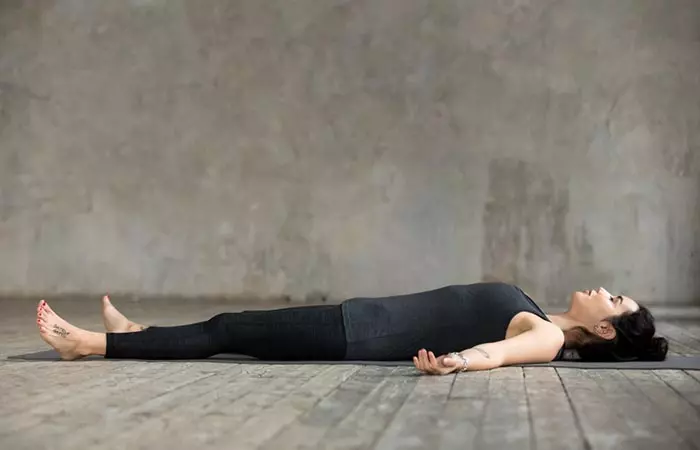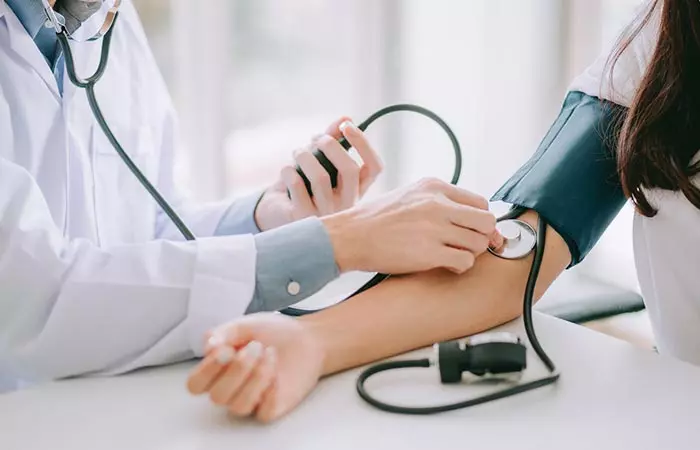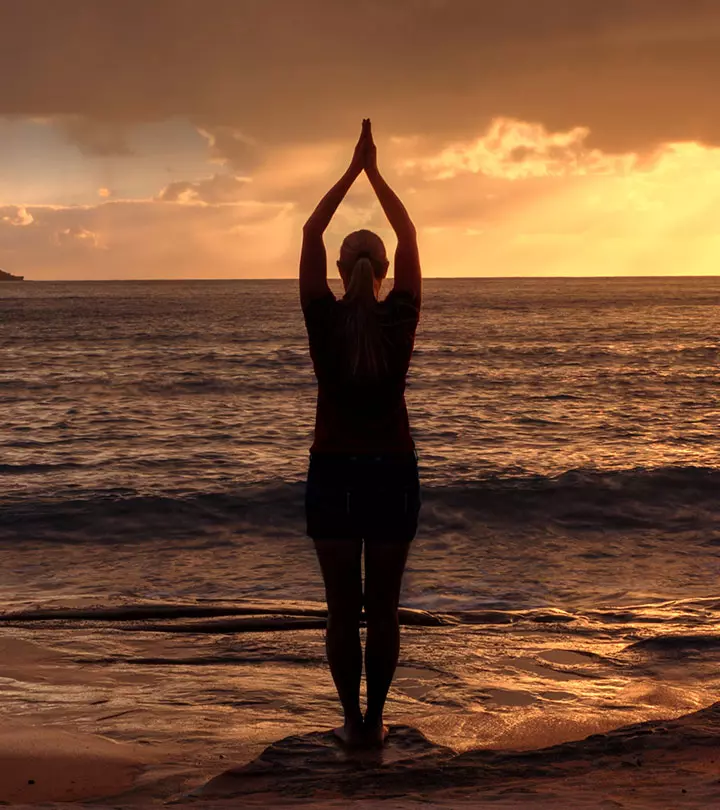Shavasana (Corpse Pose): 6 Key Benefits For Relaxation & Energy
Relax your mind, body, and soul after a yoga session with the corpse position.

Image: shutter stock
Shavasana, Savasana or Corpse Pose is an asana where Shava – Corpse; Asana – Pose; and Pronounced as – Shuh-vah-sana; Sanskrit: शवासन
Here, we will be discussing the benefits of shavasana. This pose resembles the position of a dead body. Shava (शव, ava) is the Sanskrit word for “corpse,” and Asana (आसन, sana) is the Sanskrit word for “posture” or “seat.” This posture appears simple, but it may be one of the most difficult since you must completely relax your body and mind. Actively letting your body and mind fully relax is a lot easier said than done. This pose is typically done at the end of every yoga session. It promotes deep relaxation and promotes deep healing. Its intention is not to make you fall asleep but allows your nervous system to calm down. When you get up from the pose, you should feel like a new person. This pose can also be used when you are severely weary and need to return to work fast. It is energizing and revitalizing. Scroll down to read more.
In This Article
Everything You Need To Know About Shavasana
- What You Should Know Before Practicing The Asana
- Why Is Practicing Shavasana Important?
- How To Do Shavasana
- Precautions Or Contraindications Of Shavasana
- Beginner’s Tip
- Advanced Pose Alterations
- Benefits Of Shavasana
- The Science Behind Shavasana
- Preparatory Poses
- Follow- Up Poses
Key Takeaways
- Shavasana, or the Corpse Pose, is a revitalizing, stress-relieving yoga pose.
- Feeling sleepy or tired in Shavasana could signify a lack of rest. Take fast, deep breaths to concentrate.
- You can use a folded blanket for slight head elevation to prevent any strain on the neck.
- It is a relaxing pose, usually done at the end of a yoga session.

What You Should Know Before Practicing The Asana
Shavasana promotes rest and relaxation. However, you need to restrain yourself from falling asleep as you practice it. If you feel drowsy, all you need to do is take deeper, faster breaths. Concentration is of key importance to attain the benefits of savasana. If you feel tired and sleepy, it means you are tired and sleepy and should get more rest in your daily life. As you learn to relax consciously, which is different from sleeping, your body and mind will feel refreshed and invigorated. Take a look at the shavasana image below to know the essential elements of the pose.

Level: All Levels
Style: All Styles
Duration: 7-10 minutes
Repetitions: None
Strengths: Rejuvenates the body and mind
Why Is Practicing Shavasana Important?
Shavasana, also called the Corpse Pose, is a quintessential yoga asana that is commonly used to conclude a meditation session. Despite its simple appearance, it holds profound importance. It allows the body to relax completely, reduces stress, and calms the nervous system. This pose encourages mindfulness, making you more aware of your thoughts and sensations. It allows muscles to release tension and promotes better sleep, enabling the body to recover. Furthermore, Shavasana cultivates a sense of inner peace, enhancing mental clarity and overall well-being. It acts as a bridge between physical practice and meditation, fostering holistic harmony of body, mind, and spirit.
How To Do Shavasana (Corpse Pose)

1. Lie flat on the floor, ensuring that there will be no disturbance for the duration of the pose. Make sure you are comfortable, but don’t use any pillows or cushions. It will be best if you lie on a hard surface. If your chin is tilting towards your forehead you should use a blanket under your head and neck. Your face should be parallel to the ceiling. This is the best position of the head to optimize relaxation.
2. Close your eyes.
3. Place your legs such that they are comfortably apart (hip-width apart). Make sure your legs relax completely and your toes are facing sidewards.
4. Your arms must be placed along your body and slightly apart, leaving your palms open and facing upwards.
5. Now, slowly draw attention to every area of your body, starting from your toes. As you do this, breathe slowly, yet deeply, setting your body in a state of deep relaxation. Do not fall asleep in the process. Once your body is positioned in a way to fully relax, begin to draw your attention to your breath. Initially, allow your inhalation and exhalation to be slow, deep, and smooth.
6. Breathe slowly yet deeply. This will impart complete relaxation. As you breathe in, your body will be energized, and as you breathe out, your body will calm down. Focus on yourself and your body, forgetting all other tasks. Let go and surrender! But make sure you don’t doze off. As your breathing becomes slow, deep, and smooth, you can begin to let your inhalation and exhalation happen more naturally and without restriction. As you let go of your conscious breathing, your mind will start to settle and gain mental clarity.
7. In about 10 to 12 minutes, when your body feels relaxed and refreshed, roll to one side, keeping your eyes closed. Stay in the position for about 7 to 10 minutes or longer if you feel the desire until you sit up in Sukhasana.
8. Take a few deep breaths and gain awareness of your surroundings before you open your eyes again. When you are ready to come out of the pose, roll to your right side in a fetal position and rest for a few breaths. Use your hands to slowly roll up and find a comfortable cross-legged seat and open your eyes.
 Quick Tip
Quick TipPrecautions Or Contraindications Of Shavasana

This asana is absolutely safe and can be practiced by anyone and everyone. Unless your doctor has advised you not to lie on your back, you can practice this asana.
If you are pregnant, a side-lying savasana is often recommended.
Beginner’s Tip
In our busy, stressful lives, it can be quite a task to completely let go and relax. The most difficult part about Shavasana is releasing the heads of the thigh bones so that the groin softens. If the groin doesn’t soften, it could restrict proper breathing and, therefore, create tension throughout the body. To combat this, you could place five-kilo weights on your thighs, at the groin crease, and then imagine the heads of the thigh bone pressed down because of the weight. Another difficult task is to quiet the mind. If the body is relaxed, the mind will follow. Placing a blanket under the head, weights on the thighs, or using an eye pillow are all ways in which you can help assist your body in moving towards relaxation.
Advanced Pose Alterations
1. If you experience tightness in your shoulders, chest, or back, your shoulders will not rest on the floor, and this will strain your neck. In this case, it is a good idea to slightly elevate your head and bring it to the same level as your neck. This will help soften the back of your neck. All you need to do is place a folded blanket under your head, so it ends at the top of your shoulders, while doing any yoga pose for relaxation and ease.
2. If the muscles of the lower back or hamstrings are tight, it might be a good idea to elevate your legs while you practice the corpse or savasana pose. This works well even when you have pain and discomfort in your lower back and hips. All you need to do is place a bolster right under your knees. If you don’t have a bolster at hand, you could stack up blankets and place them under your knees.
Benefits Of Shavasana (Corpse Pose)
This posture is one of the most important postures of yoga, and it has numerous benefits.
1. Brings The Body To A Meditative State
The body relaxes and goes into a deep meditative state, which in turn helps repair the cells and tissues and releases stress.
2. Relaxes And Calms The Body
Shavasana replenishes and rejuvenates your body. It is a great end to your workout, especially if it has been an intense one. The Savasana also gives space and time for the workout to sink in. It is a perfect buffer between exercise and your daily chores.
3. Reduces Blood Pressure And Anxiety

With lowered blood pressure, your body relaxes and experiences calmness and tranqulity. Your heart is relaxed and as a result, one has reduced anxiety and feels more in control.
4. Improves Concentration And Memory
The direct effect of meditation is focus and concentration. Due to the improved focus on each area of your body when practicing Shavasana, your concentration and memory automatically improve.
5. Increases Levels Of Energy

Shavasana is the fastest and safest way to gain instant energy. The 10-minute break gives your body increased energy levels, and thereby, increases your productivity.
6. Shavasana For Sleep
Shavasana promotes better sleep by calming the nervous system and reducing stress, it helps in easing insomnia and anxiety. It encourages deep relaxation, making it an effective practice for improving sleep quality and overall mental well-being, aiding in a restful night’s sleep.
Naomi, a yoga enthusiast and blogger, shares her experience of doing shavasan. She believes that shavasana is a powerful pose for relaxing which gets the blood flowing in the body. She states that, “I realized how powerful it is to rest. I fell asleep within seconds and woke up feeling more energized than ever…. Even a few minutes of Shavasana are better than nothing and can give you tremendous benefits…. Ending a yoga practice in Corpse pose is the most direct way to relax (i).”
 Trivia
TriviaWhile Shavasana offers great benefits, it is important to recognize some challenges and misconceptions that may hinder its effectiveness. Scroll down to know more.
Challenges And Misconceptions
Although Shavasana may seem easy, many practitioners struggle with restlessness or mental quietness. It’s important to realize that being deeply relaxed requires practice and that discomfort is inevitable. The pose’s effectiveness and depth of the relaxation can be increased by coming to terms with these difficulties patiently.
Understanding the challenges and misconceptions of Shavasana may help prepare you for a deeper exploration of the science behind this powerful pose. Scroll down to know more.
The Science Behind Shavasana (Corpse Pose)
Shavasana allows ultimate relaxation of your body and mind, which is just as essential as exercise and a balanced diet are.
After a strenuous workout that involves stretching, twisting, contracting, and inverting of muscles, Shavasana allows your body to rest and regroup. Even the most neglected muscles will get some time to let go of their stress in such a short span of time.
Yoga furnishes the nervous system with a whole lot of neuromuscular information. Shavasana helps your nervous system integrate this information before your mind gets busy with the regular stress of the day.
Shavasana imparts deep awareness of your mind and body. You become extremely aware of each breath you take. Therefore, it is a great introduction to deep meditation for those who are interested in it.
Yoga is a ritual. It is meant to start with a warm up, followed by the practice itself, and end with a sort of integration phase for the effects of the exercise to seep into the mind and body. Shavasana helps achieve that. It is a perfect end to a satisfying workout.
Preparatory Poses
This asana should be done after you are done with all the active asanas and pranayamas.
Follow-up Poses
Follow up the Shavasana with the Sukhasana or the easy pose.
Infographic: Top 5 Benefits Of Shavasana
Shavanasana, also known as the corpse pose, allows your body to remain in a relaxed state. This can help reduce overall fatigue and stress. While we are aware of its basic benefits, this yoga pose offers much more. Check out the infographic below to learn about Shavasana’s other health benefits!
Some thing wrong with infographic shortcode. please verify shortcode syntaxShavasana or corpse pose resembles that of a dead body. This pose is usually performed after a heavy yoga session. It helps practice mindfulness and provides deep healing that can lead to enhanced self-awareness and improved overall well-being. In such a short period, even the most neglected muscles will be able to find stress relief. Shavasana benefits your neural system by integrating neuromuscular information before your mind becomes preoccupied with the daily stresses. Shavasana provides complete body and mind relaxation, which is equally as important as exercise and a healthy diet. This asana also necessitates a high level of concentration which leaves you with reduced muscle tension, improved breathing, a feeling of rejuvenation, and improved sleep.
Frequently Asked Questions
What should I avoid during Shavasana?
Avoid tensing your body or moving too much during Shavasana, as this can interfere with your ability to relax. Additionally, keep your mind fresh and concentrated by avoiding distractions and overthinking.
What are the disadvantages of Shavasana?
There are no such disadvantages of Shavasana. But this asana should be done in a calm environment. Also, you should not move the body while doing this asana.
Why do I cry during Savasana?
Crying during yoga sessions is normal. Certain yoga poses, like Savasana, may help you release your emotions, which may eventually cause you to tear up.
Can Shavasana improve sleep quality?
Yes, anecdotal evidence suggests that Shavasana may improve sleep quality as it promotes relaxation and provides rest to the body. However, relevant studies are needed to support this claim.
Are there any benefits of Shavasana for athletes or those with an active lifestyle?
Yes, Shavasana may benefit athletes and those with an active lifestyle by helping them bring their bodies back to homeostasis or a balanced state after a rigorous workout routine. It may also promote mind and body relaxation. However, relevant research is needed to understand the further benefits of the asana for such individuals.
Can Shavasana help relieve tension and muscle soreness?
Yes, anecdotal evidence suggests that Shavasana may help relieve tension and muscle soreness by stretching stiff muscles and promoting better movement. It also relaxes tension in the entire body.
Does Shavasana assist in the recovery process after physical exertion or injury?
No, Shavasana does not assist in the recovery process after physical exertion or injury. It is simply a relaxation pose that can be practiced after the end of a yoga session or high-intensity workout to relax the mind and body.
Illustration: How To Do The Shavasana And What Are Its Benefits

Image: Stable Diffusion/StyleCraze Design Team
Relax and restore your body and mind with the calming corpse pose. Check out the video below to learn how to do Savasana, its benefits, and contraindications.
Personal Experience: Source
StyleCraze's articles are interwoven with authentic personal narratives that provide depth and resonance to our content. Below are the sources of the personal accounts referenced in this article.
i. The Significance of Shavasana and How it Can Enhance Your Yoga Practicehttps://medium.com/wholistique/the-significance-of-shavasana-and-how-it-can-enhance-your-yoga-practice-2249b6195d7d
Read full bio of Patrick Franco
Read full bio of Shirin Mehdi
Read full bio of Ravi Teja Tadimalla
Read full bio of Himanshi Mahajan




























Community Experiences
Join the conversation and become a part of our empowering community! Share your stories, experiences, and insights to connect with other beauty, lifestyle, and health enthusiasts.